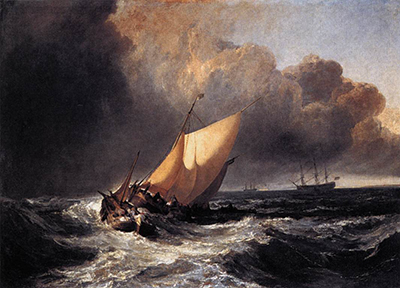This painting is currently on loan at The National Gallery in London, UK from the from The Capricorn Foundation. It was finished in 1801 and is over two metres wide.
Within this composition we find a small ship desperately attempting to stay afloat as it receives an extraordinary barrage of rough seas. The crew look terrified, some of whom are on the verge of falling into the water, with little chance of being rescued. This scene is Turner at his emotional and expressive best, drawing us into this scene of terror, as if we were there on the day. The use of colour and lighting, for which he was well respected, are essential in building this atmosphere in the mind of the viewer. See also Dutch Fishing Boats in a Storm.
Dutch Boats in a Gale is sometimes called The Bridgewater Sea Piece and features several dutch boats heading for a potential collision whilst fighting against the elements in this powerful depiction from Turner. The lighting is dramatic dark and frightening, as we get into the fearful minds of the respective crews. It is almost a seascape in the style of Rembrandt or Caravaggio, though with the additions of this artist's romantic approach for which he became exceptionally popular. The reason for its alternative title lies in the fact that it was commissioned by the 3rd Duke of Bridgewater in order to match a number of his existing artworks of a similar theme from previous centuries.
Maritime art was a key factor in Turner's oeuvre, and we can see several similar compositions to this one. He produced depictions of Dutch boats on many occasions and also gave us Fishermen at Sea, where the dimly lit style can be found again. He typically concentrated one's eyes on a single vessel, placed relatively close to the viewer, before then adding additional ships in the far background, so as to provide an element of perspective. In all there would be turbulent waves, threatening the ships relentlessly as they went about their respective journeys. He loved to capture the vulnerability of man against nature and did so in a variety of ways, including his famous series of snow storms.




